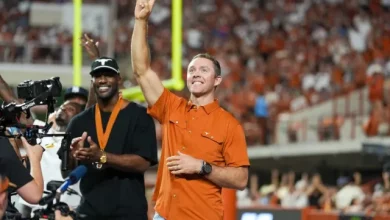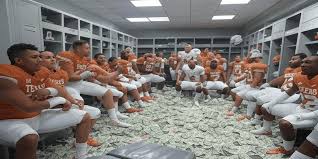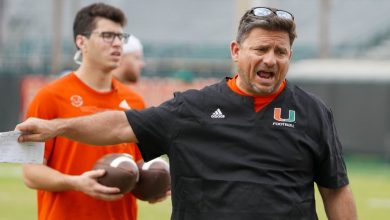Ahead of the NFL draft, a college football analyst delivers a sobering assessment on Alabama quarterback Jalen Milroe.

Jalen Milroe’s NFL Draft Prospects: A Sobering Assessment
As the NFL Draft approaches, Alabama quarterback Jalen Milroe is one of the more intriguing, yet polarizing figures in college football. After spending a couple of seasons as Bryce Young’s backup, Milroe finally got his opportunity to start for the Crimson Tide in 2023. His performance throughout the season has generated both excitement and skepticism among NFL scouts and analysts.
Milroe is an athletic marvel, but his rawness as a passer and inconsistencies in decision-making raise serious questions about his ability to translate to the NFL. To evaluate Milroe’s future in the NFL, it’s essential to break down his skill set, assess his strengths and weaknesses, and consider his potential path forward.
Physical Attributes: An Athlete at Quarterback
One of the first things that stands out when watching Milroe is his physical attributes. Standing at 6’2″ and weighing around 220 pounds, he has the ideal size and frame to succeed at the NFL level. But it’s his athleticism that truly sets him apart. Milroe is an exceptional runner with elite speed and agility for a quarterback.
In a league that’s increasingly valuing dual-threat quarterbacks, Milroe’s running ability is a major asset. Throughout his college career, he displayed the ability to create explosive plays with his legs. Milroe has the capacity to escape pressure in the pocket, extend plays, and pick up chunk yardage on the ground. He has breakaway speed and is capable of taking over a game with his legs—something that will likely be heavily emphasized as he transitions to the pros.
However, as we’ve seen in the past, the NFL demands far more from quarterbacks than just athleticism. Mobility alone does not guarantee success. Milroe’s skills as a passer will ultimately determine his long-term viability in the NFL.
The Passing Game: A Work in Progress
Milroe’s biggest concern is his inconsistency as a passer. At Alabama, he often struggled with accuracy, timing, and mechanics. While he certainly had his moments—most notably a 5-touchdown performance against Texas A&M in 2023—there were far too many instances where his passing left much to be desired.
Milroe has a strong arm, capable of making deep throws down the field, but he often struggles with touch and placement. His accuracy on intermediate routes was spotty, and his decision-making at times bordered on reckless. In the NFL, the level of competition and defensive sophistication will punish these mistakes more severely than at the college level. NFL defenders are faster, more experienced, and better equipped to capitalize on a quarterback’s poor mechanics and tendencies.
Milroe’s tendency to force the ball into tight windows—often in situations where a more measured decision would be prudent—was a common theme throughout his 2023 season. His mechanics often broke down under pressure, leading to inaccurate passes, especially on throws to the outside and downfield. While his ability to throw the deep ball is impressive, his intermediate and short-range throws leave much to be desired in terms of precision.
One of the key aspects of quarterbacking in the NFL is the ability to read defenses and make quick, correct decisions under pressure. While Milroe showed flashes of this, particularly on quick-hitting plays and RPO (run-pass option) systems, his overall decision-making process remains a work in progress. His progression through reads can be slow, and he occasionally locks onto one receiver, making it easier for defenders to predict his intentions. This lack of recognition of defensive schemes will be a hurdle for Milroe to overcome in the NFL.
Processing Speed: The Mental Side of the Game
Perhaps one of the biggest questions surrounding Milroe is his ability to process the game quickly at the NFL level. Milroe has the raw athletic ability to excel in a fast-paced, high-pressure environment, but his mental processing ability has been inconsistent.
At Alabama, Milroe was surrounded by elite talent, which often masked some of his flaws. The Crimson Tide’s offensive scheme, built on heavy RPOs and play-action, allowed him to make relatively simple reads. When Milroe was forced to move beyond that scheme, his mental processing was more erratic. Against more complex defenses, his struggles to quickly diagnose coverages and react accordingly became apparent.
In the NFL, quarterbacks are required to process defenses much faster. They must be able to scan the field, make decisions on the fly, and avoid panicking when a pocket begins to collapse. Milroe’s ability to improve his mental processing will be just as important as his development as a passer. If he doesn’t significantly improve his recognition and reaction time, it will be difficult for him to thrive as a starting quarterback in the NFL.
Comparisons to Dual-Threat Quarterbacks
Milroe’s profile has drawn comparisons to current and former NFL quarterbacks who rely heavily on their athleticism, including players like Lamar Jackson, Jalen Hurts, and even Cam Newton. While Milroe certainly has the physical tools to make an impact as a dual-threat quarterback, it’s essential to note that these quarterbacks were able to develop their passing games to match their elite athleticism.
Jackson, Hurts, and Newton all struggled early in their careers with passing accuracy and consistency. However, they all demonstrated the work ethic and football IQ needed to improve their mechanics, decision-making, and overall passing game. Milroe, however, has yet to show that he has the same level of growth potential. His trajectory as a passer will need to mirror that of these quarterbacks for him to reach his potential as a starter in the NFL.
Hurts, for instance, was once considered a developmental prospect because of his struggles as a passer. He worked tirelessly on his footwork, mechanics, and decision-making, which helped him evolve into an MVP-caliber player in just a few seasons. Milroe will need to demonstrate similar improvements in order to reach that level.
What Does Milroe Need to Improve Before the NFL?
Before he can make a successful transition to the NFL, Milroe will need to work on several aspects of his game:
- Accuracy and Consistency: This is the most glaring flaw in Milroe’s game. His accuracy needs to improve, particularly on intermediate routes, and he needs to develop better touch on the ball. His deep-ball accuracy is a strength, but his short and mid-range passing is often off target.
- Mechanics: Milroe’s throwing mechanics often break down under pressure. His footwork can become sloppy, leading to inaccurate throws. Improving his mechanics, especially his footwork, will help him make more consistent passes and avoid unnecessary mistakes.
- Decision-Making: Milroe must learn to trust his reads and avoid forcing throws. In college, he often made risky decisions that worked out in his favor due to his athleticism and Alabama’s talented roster. In the NFL, those types of decisions will be punished.
- Mental Processing: Milroe needs to develop quicker and more accurate mental processing. Being able to read defenses, make faster decisions, and go through progressions efficiently will be key for his success in the NFL.
- Development as a Pocket Passer: While Milroe is a fantastic athlete, his ability to thrive as a traditional pocket passer is a major question mark. He’ll need to develop a more consistent ability to make throws from the pocket, especially under pressure.
Conclusion: A Developmental Project with Tremendous Upside
Jalen Milroe’s potential as an NFL quarterback is tantalizing, but he remains a work in progress. His raw athleticism, arm strength, and ability to make plays with his legs give him the potential to be a dynamic player at the next level. However, his inconsistency as a passer, mental processing issues, and lack of polish as a quarterback will make him a developmental project for any NFL team that drafts him.
Milroe has the physical tools to succeed, but his success will ultimately depend on his ability to develop his passing mechanics, decision-making, and mental processing. Teams that select him will likely need to bring him along slowly, working on his development in a system that will allow him to grow as a passer while also taking advantage of his running ability.
While there’s no denying Milroe’s athletic gifts, his future in the NFL is far from guaranteed. If he can develop his skills as a passer, he has the potential to become a star. However, the road to becoming a starting quarterback in the NFL is fraught with challenges, and Milroe will need to put in the work to reach his potential. The question is not whether Milroe has the talent—it’s whether he has the commitment and ability to become a complete quarterback at the next level.
As the draft approaches, Milroe remains one of the most intriguing—and uncertain—prospects in the class. Teams will have to weigh his immense upside against his significant flaws to determine if he’s worth the investment. If they believe in his development, Milroe could be the type of quarterback who surprises everyone. But it’s just as likely that his NFL journey will be a long, slow climb to consistency.









